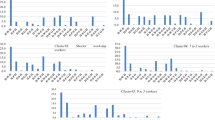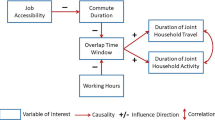Abstract
This study examines the journey to work as a multiple-purpose trip (home-to-home circuit). Using disaggregate travel diary data collected over 35 consecutive days, the study shows the importance of the multi-purpose work trip in the overall travel pattern of the urban household. A large proportion of many households' total travel is undertaken in conjunction with the journey to and from work. The paper also examines the nature of these work-induced travel linkages and finds that many types of urban establishments depend heavily upon stops made in connection with the work trip. In fact, there is a group of urban functions that have stronger travel links with the workplace than with the home or with any other type of urban establishment. The study examines the implications of the multi-purpose journey to work for policies regarding mode use and the viability of centrally-located urban functions.
Similar content being viewed by others
References
Alonso, W. (1964). Location and Land Use. Cambridge: Harvard University Press.
Baker, L. L. H. and Goddard, J. B. (1972). “Inter-sectoral contact flows and office location in central London,” in A. G. Wilson, ed., Patterns and Processes in Urban and Regional Systems. London: Pion Ltd.
Chapin, F. S. (1974). Human Activity Patterns in the City: Things People do in Time and Space. New York: John Wiley & Sons.
Damm, D. (1979). Toward a Model of Activity Scheduling Behavior. Unpublished Ph. D. thesis, Department of Civil Engineering, MIT, Cambridge, MA.
Garrison, W. and Worrall, R. (1966). Monitoring Urban Travel. Final Report of Project 2–8, Estimation and Evaluation of Diverted and Generated (Induced) Traffic, Department of Civil Engineering and The Transportation Center, North-western University, Evanston, IL.
Goddard, J. (1970). “Functional regions within the city centre: a study by factor analysis of taxi flows in central London,” Transactions of the Institute of British Geographers 49: 161–182.
Goodman, L. A. (1963). “Statistical methods for the preliminary analysis of transaction flows,” Econometrica 31: 197–208.
Hanson, S. (1979). “Urban travel linkages,” in D. A. Hensher and P. Stopher (eds.), Behavioral Travel Modelling. London: Croom Helm, Ltd.
Hanson, S. and Marble, D. F. (1971). “A preliminary typology of urban travel linkages,” East Lake Geographer 7: 49–59.
Hartgen, D. (1973). The Influence of Attitudinal and Situational variables on Urban Mode Choice. Preliminary Report no. 41, Research and Applied Systems Sectign, New York State Department of Transportation.
Hensher, D. (1972). Consumer Preferences in Urban Trip-Making. Commonwealth Bureau of Roads Working Paper No. 1, Melbourne, Australia.
Hille, S. J. and Martin, T. K. (1967). “Consumer preference in transportation,” Highway Research Record 197: 36–43.
Keck, C. (1974). “Effects of the energy shortages on reported household travel patterns in small urban areas,” Preliminary Research Report No. 67, NYSDOT: Planning Division, Albany, NY.
Liepmann, K. K. (1944). The Journey to Work: Its Significancefor Industrial and Community Life. London: Kegan, Paul, Trench, Trubner.
Marble, D. F., Hanson, P. O. and Hanson, S. (1972). Household Travel Behavior Study Report No. 1: Field Operations and Questionnaires. Evanston, Illinois: The Transportation Center at Northwestern University.
Marble, D. F. (1967). “A theoretical exploration of individual travel behavior,” in W. Garrison and D. F. Marble, eds., Quantitative Geography, Part 1. Evanston, IL: Northwestern University Press.
Marble, D. F. (1964). “A simple Markovian model of trip structures in a metropolitan region,” Proceedings of the Western Section of Regional Science Association, 150–151.
Meyer, J. R., Kain, J. F. and Wohl, M. (eds.) (1965). The Urban Transportation Problem. Cambridge: Harvard University Press.
Mitchell, R. B. and Rapkin, C. (1954). Urban Traffic: A Function of Land Use. New York: Columbia University Press.
Nystuen, J. (1967). “A theory and stimulation of intraurban travel,” in W. Garrison and D. F. Marble (eds.), Quantitative Geography, Part 1. Evanston, IL: Northwestern University Press.
Oster, C. (1978). “Household tripmaking to multiple destinations: the overlooked urban travel pattern,” Traffic Quarterly 32: 511–529.
Recker, W. and Stevens, R. F. (1976). “Attitudinal models of mode choice: the multi-nomial case for selected nonwork trips,” Transportation 5: 355–375.
Savage, I. R. and Deutsch, K. W. (1960). “A statistical model of transaction flows,” Econometrica 28: 551–572.
Selinger, C. (1977). “Managing transportation demand by alternative work schedule techniques,” Transportation Research Board Special Report 172: 67–74.
Slater, P. B. (1974). “Exploratory analyses of trip distribution data,” Journal of Regional Science 14: 377–388.
Stopher, P. R. (1968). “Predicting travel model choice for the journey to work,” Traffic Engineering and Control 9: 436–439.
Westelius, O. (1973). The Individual's Way of Choosing Between Alternative Outlets. Stockholm: Svensk Byggtjanst.
Wheeler, J. O. (1970). “The structure of metropolitan work-trips,” Professional Geographer 22: 152–158.
Author information
Authors and Affiliations
Rights and permissions
About this article
Cite this article
Hanson, S. The importance of the multi-purpose journey to work in urban travel behavior. Transportation 9, 229–248 (1980). https://doi.org/10.1007/BF00153866
Issue Date:
DOI: https://doi.org/10.1007/BF00153866




